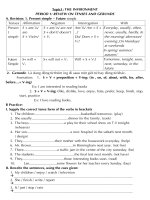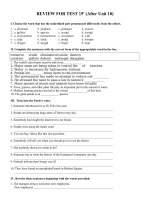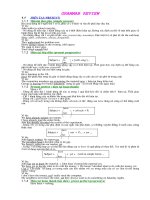Dr birtwhistle hypertension PGY2 review 2014
Bạn đang xem bản rút gọn của tài liệu. Xem và tải ngay bản đầy đủ của tài liệu tại đây (518.01 KB, 38 trang )
Hypertension 2014
Family Medicine
Richard Birtwhistle MD
CFPC Objectives- Hypertension
1 Screen for hypertension.
2 Use correct technique and equipment to measure blood pressure.
3 Make the diagnosis of hypertension only after multiple BP readings (i.e., at different
times and during different visits).
4 In patients with an established diagnosis of hypertension, assess and re-evaluate
periodically the overall cardiovascular risk and end-organ complications:
a) Take an appropriate history.
b) Do the appropriate physical examination.
c) Arrange appropriate laboratory investigations.
5 In appropriate patients with hypertension (e.g., young patients requiring multiple
medications, patients with an abdominal bruit, patients with hypokalemia in the absence
of diuretics):
a) Suspect secondary hypertension.
b) Investigate appropriately.
6 Suggest individualized lifestyle modifications to patients with hypertension. (e.g.,
weight loss, exercise, limit alcohol consumption, dietary changes).
7 In a patient diagnosed with hypertension, treat the hypertension with appropriate
pharmacologic therapy (e.g., consider the patient’s age, concomitant disorders, other
cardiovascular risk factors).
8 Given a patient with the signs and symptoms of hypertensive urgency or crisis, make
the diagnosis and treat promptly.
9 In all patients diagnosed with hypertension, assess response to treatment, medication
compliance, and side effects at follow-up visits.
CFPC Objectives Hypertension
1. Screen for hypertension
2012 Canadian Task Force on Preventive Health Care
Recommendations
•
We recommend blood pressure measurement at all appropriate
primary care visitsi,ii). (Strong recommendation; moderate quality
evidence)
•
We recommend that blood pressure be measured according to the
current techniques described in the Canadian Hypertension
Education Program (CHEP) recommendations for office and out-of-
office (ambulatory) blood pressure measurement). (Strong
recommendation; moderate quality evidence)
•
For people who are found to have an elevated blood pressure
during screening, the CHEP criteria for assessment and diagnosis
of hypertension should be applied to determine whether the patient
meets diagnostic criteria for hypertension. (Strong
recommendation; moderate quality evidence)
2. Use correct technique and equipment to measure blood pressure
Blood Pressure Assessment:
Patient preparation and posture
Standardized Preparation:
Patient
1. No acute anxiety, stress or pain.
2. No caffeine, smoking or nicotine in the
preceding 30 minutes.
3. No use of substances containing adrenergic
stimulants such as phenylephrine or
pseudoephedrine (may be present in nasal
decongestants or ophthalmic drops).
4. Bladder and bowel comfortable.
5. No tight clothing on arm or forearm.
6. Quiet room with comfortable temperature
7. Rest for at least 5 minutes before measurement
8. Patient should stay silent prior and during the
procedure.
Blood Pressure Assessment:
Patient preparation and posture
Standardized technique:
Posture
The patient should be calmly seated with his
or her back well supported and arm
supported at the level of the heart.
His or her feet should touch the floor and legs
should not be crossed.
Recommended Equipment for
Measuring Blood Pressure
Automated oscillometric
devices:
•
Use a validated automated device
according to BHS, AAMI or IP
clinical protocols.
•
For home blood pressure
measurement devices, a logo on
the packaging ensures that this
type of device and model meets
the international standards for
accurate blood pressure
measurement.
AAMI=Association for the Advancement of Medical Instrumentation;
BHS=British Hypertension Society; IP: International Protocol.
Use an appropriate size cuff
Arm circumference (cm) Size of Cuff (cm)
From 18 to 26 9 x 18 (child)
From 26 to 33
12 x 23 (standard adult
model)
From 33 to 41 15 x 33 (large)
More than 41
18 x 36 (extra large,
obese)
For automated devices, follow the manufacturer’s directions.
For manual readings using a stethoscope and sphygmomanometer, use the table as a guide.
CFPC Objectives
Hypertension
1. Screen for hypertension
2. Use correct technique and equipment to measure blood
pressure
3. Make the diagnosis of hypertension only after multiple
BP readings (i.e., at different times and during different
visits).
Criteria for the diagnosis of hypertension and
recommendations for follow-up
BP: 140-179 / 90-109
BP: 140-179 / 90-109
ABPM (If available)
ABPM (If available)
Clinic BPM
Clinic BPM
Home BPM (If available)
Home BPM (If available)
Yes
Hypertension Visit 2
Target Organ Damage
or Diabetes
or Chronic Kidney Disease
or BP >180/110?
Hypertension Visit 2
Target Organ Damage
or Diabetes
or Chronic Kidney Disease
or BP >180/110?
Hypertension Visit 1
BP Measurement,
History and Physical
examination
Hypertension Visit 1
BP Measurement,
History and Physical
examination
Hypertensive
Urgency /
Emergency
Hypertensive
Urgency /
Emergency
Diagnosis
of HTN
Diagnosis
of HTN
No
Elevated Out of
the Office BP
measurement
Elevated Out of
the Office BP
measurement
Elevated Random
Office BP
Measurement
Elevated Random
Office BP
Measurement
Diagnostic algorithm for high Blood Pressure including
Office, ABPM and Home Blood Pressure Measurement
BP: 140-179 / 90-109
BP: 140-179 / 90-109
ABPM (If available)
ABPM (If available)
Clinic BP
Clinic BP
HBPM
HBPM
Diagnosis
of HTN
Awake BP
≥ 135 SBP or
≥ 85 DBP
Or 24-hour
≥ 130 SBP or
≥ 80 DBP
Awake BP
≥ 135 SBP or
≥ 85 DBP
Or 24-hour
≥ 130 SBP or
≥ 80 DBP
Awake BP
< 135/85 and
24-hour
< 130/80
Awake BP
< 135/85 and
24-hour
< 130/80
Continue to
follow-up
Diagnosis
of HTN
Hypertension visit 3
≥ 160 SBP or
≥ 100 DBP
≥ 140 SBP or
≥ 90 DBP
< 140 / 90
Diagnosis
of HTN
Continue to
follow-up
< 160 / 100
Hypertension visit 4-5
ABPM or HBPM
or
≥ 135
SBP or ≥
DBP 85
≥ 135
SBP or ≥
DBP 85
< 135/85
< 135/85
Diagnosis
of HTN
Continue to
follow-up
or
CFPC Objectives
Hypertension
4. In patients with an established diagnosis of
hypertension, assess and re-evaluate periodically the
overall cardiovascular risk and end-organ complications:
a) Take an appropriate history.
b) Do the appropriate physical examination.
c) Arrange appropriate laboratory investigations.
5. In appropriate patients with hypertension (e.g., young
patients requiring multiple medications, patients with an
abdominal bruit, patients with hypokalemia in the
absence of diuretics):
a) Suspect secondary hypertension.
b) Investigate appropriately.
Diagnostic Work-Up
•
History and physical
–
Review for CV risk factors,
evidence of TOD and HTN
and monitor treatment
•
Routine laboratory tests (grade D)
–
Urinalysis
–
CBC, blood chemistry
(potassium, sodium,
creatinine), fasting glucose,
fasting TC, HDL, LDL,
triglycerides
–
Standard 12-lead ECG
•
Lab tests for specific subgroups
–
Diabetes & renal disease:
protein excretion
–
Elevated creatinine, hx of
renal disease or proteinuria -
renal ultrasound
Search for Target Organ Damage
•
Cerebrovascular
–
TIA
–
Ischemic or Hemorrhagic
Stroke
•
Hypertensive retinopathy
•
Left ventricular dysfunction
•
Coronary artery disease
–
Angina or prior MI
–
CHF
•
Chronic kidney disease
•
Peripheral arterial disease
Search for Cardiovascular Risk Factors
•
Hypertension
•
Male
•
Increasing age
•
Peripheral arterial
disease
•
Previous stroke or TIA
•
Microalbuminuria or
proteinuria
•
Diabetes mellitus
•
Smoking
Source: 2011 CHEP
Recommendations
•
Family history of
premature CVD
•
Chronic kidney
disease
•
Abnormal lipid
profile
•
Sedentary lifestyle
•
Left ventricular
hypertrophy
Search for exogenous potentially modifiable factors that can
induce/aggravate hypertension
•
Prescription Drugs:
–
NSAIDs, including coxibs
–
Corticosteroids and anabolic steroids
–
Oral contraceptive and sex hormones
–
Vasoconstricting/sympathomimetic decongestants
–
Calcineurin inhibitors (cyclosporin, tacrolimus)
–
Erythropoietin and analogues
–
Antidepressants: Monoamine oxidase inhibitors (MAOIs), SNRIs,
SSRIs
–
Midodrine
•
Other:
–
Licorice root
–
Stimulants including cocaine
–
Salt
–
Excessive alcohol use
III. Assessment of the overall cardiovascular risk
CFPC Objectives
Hypertension
6. Suggest individualized lifestyle modifications to patients
with hypertension. (e.g., weight loss, exercise, limit
alcohol consumption, dietary changes).
7. In a patient diagnosed with hypertension, treat the
hypertension with appropriate pharmacologic therapy
(e.g., consider the patient’s age, concomitant disorders,
other cardiovascular risk factors).
Lifestyle Recommendations for Prevention and
Treatment of Hypertension
To reduce the possibility of becoming hypertensive,
Reduce sodium intake to less than 1500 mg/day
•
Healthy diet: high in fresh fruits, vegetables, low fat dairy products,
dietary and soluble fibre, whole grains and protein from plant sources,
low in saturated fat, cholesterol and salt in accordance with Canada's
Guide to Healthy Eating.
I. Regular physical activity: accumulation of 30-60 minutes of moderate
intensity dynamic exercise 4-7 days per week in addition to daily
activities; For non-hypertensive or stage 1 hypertensive
individuals, the use of resistance or weight training exercise (such
as free weight lifting, fixed-weight lifting, or handgrip exercise)
does not adversely influence blood pressure.
•
Low risk alcohol consumption: (≤2 standard drinks/day and less
than 14/week for men and less than 9/week for women)
•
Attaining and maintaining ideal body weight (BMI 18.5-24.9 kg/m
2
)
•
Waist Circumference: Men <102 cm Women <88 cm
•
Tobacco free environment
Usual blood pressure threshold values for initiation of
pharmacological treatment of hypertension
I. Indications for Pharmacotherapy
General population (including
CKD) (CHEP 2011**)
140/90
Very elderly (>80) (CHEP 2013**) 150
Diabetes (CHEP 2000**) 130/80
Very low CV risk (CHEP 2000**) 160/100
I. Indications for Pharmacotherapy
after diagnosis of hypertension (1)
•
Patients at low risk with stage 1 hypertension (140-
159/90-99 mmHg)
•
lifestyle modification can be the sole
therapy.
•
Patients with target organ damage (e.g. left
ventricular hypertrophy) or chronic kidney disease
(140-159/90-99 mmHg)
•
Treat with pharmacotherapy
•
Patients with diabetes should continue to be
considered for pharmacotherapy if the blood pressure
is equal or over 130/80 mmHg
V. Treatment of Adults with Systolic/Diastolic Hypertension
without Other Compelling Indications
TARGET <140/90 mmHg
INITIAL TREATMENT AND MONOTHERAPY
•
BBs are not indicated as first line therapy for age 60 and above
Beta-
blocker*
Long acting
CCB
Thiazide
ACEI
ARB
Lifestyle modification therapy
ACEI, ARB and direct renin inhibitors are contraindicated in pregnancy and
caution is required in prescribing to women of child bearing potential
A combination of 2 first line drugs may be considered as initial therapy if the blood pressure
is >20 mmHg systolic or >10 mmHg diastolic above target
V. Considerations Regarding the Choice of First-
Line Therapy
•
Use caution in initiating therapy with 2 drugs in whom adverse events are
more likely (e.g. frail elderly, those with postural hypotension or who are
dehydrated).
•
ACE inhibitors, renin inhibitors and ARBs are contraindicated in pregnancy
and caution is required in prescribing to women of child bearing potential.
•
Beta adrenergic blockers are not recommended for patients age 60 and
over without another compelling indication.
•
Diuretic-induced hypokalemia should be avoided through the use of
potassium sparing agents if required.
•
The use of dual therapy with an ACE inhibitor and an ARB should only be
considered in selected and closely monitored people with advanced heart
failure or proteinuric nephropathy.
•
ACE-inhibitors are not recommended (as monotherapy)
for black patients without another compelling indication.
V. Add-on Therapy for Systolic/Diastolic Hypertension
without Other Compelling Indications
IF BLOOD PRESSURE IS NOT
CONTROLLED CONSIDER
•
Nonadherence
•
Secondary HTN
•
Interfering drugs or lifestyle
•
White coat effect
If blood pressure is still not controlled, or there are
adverse effects, other classes of antihypertensive drugs
may be combined (such as alpha blockers or centrally
acting agents).
2. Triple or Quadruple Therapy
1. Add-on Therapy
If partial response to monotherapy
Drug Combinations
When combining drugs, use first-line therapies.
•
Two drug combinations of beta blockers, ACE inhibitors
and angiotensin receptor blockers have not been proven
to have additive hypotensive effects. Therefore these
potential two drug combinations should not be used
unless there is a compelling (non blood pressure
lowering) indication
•
Combinations of an ACEI with an ARB do not reduce
cardiovascular events more than the ACEI alone and
have more adverse effects therefore are not generally
recommended
Drug Combinations cont’d
•
Caution should be exercised in combining a non
dihydropyridine CCB (eg verapamil or diltiazem) and a beta
blocker to reduce the risk of bradycardia or heart block.
•
Monitor serum creatinine and potassium when combining K
sparing diuretics, ACE inhibitors and/or angiotensin
receptor blockers.
•
If a diuretic is not used as first or second line therapy, triple
dose therapy should include a diuretic, when not
contraindicated.
III. Treatment Algorithm for Isolated Systolic
Hypertension without Other Compelling Indications
INITIAL TREATMENT AND MONOTHERAPY
Thiazide
diuretic
Long-acting
DHP CCB
Lifestyle modification
therapy
ARB
TARGET <140 mmHg (< 150 mmHg if age > 80 years)









